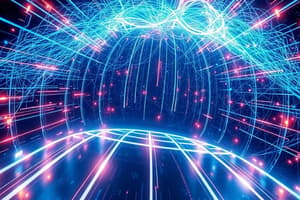Podcast
Questions and Answers
What physiological process triggers the defecation reflex?
What physiological process triggers the defecation reflex?
- Distension of the rectum (correct)
- Contraction of the abdominal muscles
- Stretching of the colon
- Relaxation of the anal sphincters
Which structure prevents the reflux of colonic contents into the sterile ileum?
Which structure prevents the reflux of colonic contents into the sterile ileum?
- Colon
- Ileocecal valve (correct)
- Rectum
- Anal sphincter
What is the typical frequency of bowel movements in most individuals?
What is the typical frequency of bowel movements in most individuals?
- Once every two days
- 4 to 5 times daily
- 1 to 3 times daily (correct)
- 1 to 2 times weekly
The ileocecal valve opens due to which of the following conditions?
The ileocecal valve opens due to which of the following conditions?
Which systems are coordinated for the complex function of defecation?
Which systems are coordinated for the complex function of defecation?
What is the primary role of the anal sphincters during defecation?
What is the primary role of the anal sphincters during defecation?
What physiological event primarily leads to stool formation?
What physiological event primarily leads to stool formation?
Which factor does NOT influence the frequency of defecation?
Which factor does NOT influence the frequency of defecation?
What primarily influences gastrointestinal secretions and local blood flow?
What primarily influences gastrointestinal secretions and local blood flow?
Which receptor type is responsible for detecting mechanical events such as stretching in the gastrointestinal tract?
Which receptor type is responsible for detecting mechanical events such as stretching in the gastrointestinal tract?
Which enteric plexus primarily regulates gastrointestinal tract movements?
Which enteric plexus primarily regulates gastrointestinal tract movements?
How do the enteric plexuses communicate with the central nervous system?
How do the enteric plexuses communicate with the central nervous system?
What type of receptors respond to the presence of nutrients and end products of digestion in the gastrointestinal lumen?
What type of receptors respond to the presence of nutrients and end products of digestion in the gastrointestinal lumen?
What is one effect of stimulating the receptors in the gastrointestinal tract?
What is one effect of stimulating the receptors in the gastrointestinal tract?
What term describes reflexes that originate outside the digestive system?
What term describes reflexes that originate outside the digestive system?
Which component is NOT part of the extrinsic neurons connected to the gastrointestinal system?
Which component is NOT part of the extrinsic neurons connected to the gastrointestinal system?
What is another name for the enteric nervous system (ENS)?
What is another name for the enteric nervous system (ENS)?
Where is the enteric nervous system located?
Where is the enteric nervous system located?
Which of the following pathways is involved in the sensory flow of information to the intrinsic interstitial cells?
Which of the following pathways is involved in the sensory flow of information to the intrinsic interstitial cells?
What role do gastrointestinal peptides play in the regulation of GI activities?
What role do gastrointestinal peptides play in the regulation of GI activities?
Which structure receives outflow from both intrinsic and extrinsic control systems?
Which structure receives outflow from both intrinsic and extrinsic control systems?
Which part of the autonomic nervous system includes both intrinsic and extrinsic components for GI control?
Which part of the autonomic nervous system includes both intrinsic and extrinsic components for GI control?
What is the primary composition of an average adult's feces?
What is the primary composition of an average adult's feces?
Which muscles are primarily responsible for the closure of the anus?
Which muscles are primarily responsible for the closure of the anus?
Which nerve stimulates the contraction of the external anal sphincter muscle?
Which nerve stimulates the contraction of the external anal sphincter muscle?
What prevents the continual dribble of fecal matter through the anus?
What prevents the continual dribble of fecal matter through the anus?
What is the average daily output of stool for an adult?
What is the average daily output of stool for an adult?
Which component makes up about one-third of the dry matter in feces?
Which component makes up about one-third of the dry matter in feces?
What role does the puborectalis muscle play in maintaining continence?
What role does the puborectalis muscle play in maintaining continence?
What characterizes the internal anal sphincter muscle?
What characterizes the internal anal sphincter muscle?
What is a primary function of Cholecystokinin (CCK)?
What is a primary function of Cholecystokinin (CCK)?
Who discovered Secretin as the first GIT hormone?
Who discovered Secretin as the first GIT hormone?
Which hormone is primarily responsible for stimulating the pancreatic secretion of bicarbonate?
Which hormone is primarily responsible for stimulating the pancreatic secretion of bicarbonate?
During fasting, which hormone stimulates the migrating motor complex?
During fasting, which hormone stimulates the migrating motor complex?
What effect does Glucagon-Like Peptide I have on gastric emptying?
What effect does Glucagon-Like Peptide I have on gastric emptying?
Which trigger prompts the I cells of the duodenum and jejunum to secrete Cholecystokinin (CCK)?
Which trigger prompts the I cells of the duodenum and jejunum to secrete Cholecystokinin (CCK)?
What is one of the effects of Secretin on gastric acid secretion?
What is one of the effects of Secretin on gastric acid secretion?
Which hormone is involved in moderating appetite during meals?
Which hormone is involved in moderating appetite during meals?
Study Notes
Defecation Mechanisms
- Defecation refers to the expulsion of feces from the digestive tract through the anus.
- Triggered by the distension of the rectum, defecation is a spinal reflex and requires coordinated efforts from the gastrointestinal, nervous, and musculoskeletal systems.
- Frequency of bowel movements varies by age and diet, with most individuals defecating 1 to 3 times daily.
Important Structures
- Ileocecal Valve: Connects the ileum to the cecum, preventing backflow of colonic contents. It opens with peristalsis and is regulated by pressures in the ileum and colon.
- Anal Sphincters: Comprised of internal (involuntary) and external (voluntary) sphincters, both tonically contracted to maintain anal closure and continence.
Stool Formation and Composition
- Average daily fecal output for adults is 60-80 g; diarrhea can increase this to over 200 g.
- Feces consist of approx. 1/4 dry matter, 1/3 of which is bacteria.
- Typical input includes 1 to 2 L of isotonic chyme and output is around 200-250 mL of stool per 24 hours.
Maintenance of Continence
- Continence is regulated by the transverse rectal fold, puborectal muscles, and anal sphincters.
- Tonic contraction of sphincters prevents the leakage of fecal matter, maintaining a 90-degree angle between the anus and rectum to inhibit defecation.
Control of Gastrointestinal Functions
- GI functions are influenced by sensory input to intrinsic (enteric) and extrinsic nervous systems.
- Regulatory mechanisms include long reflexes (external), short reflexes (within the GI), and gastrointestinal peptides.
Enteric Nervous System (ENS)
- ENS, termed the "mini brain," operates throughout the digestive tract, managing secretions and blood flow.
- Myenteric Plexus: Positioned between muscle layers, it primarily controls GI movements. Plexuses communicate via interneurons and connect to the CNS through various nerves.
Receptors in the ENS
- Mechanoreceptors: Detect stretching in gut walls.
- Chemoreceptors/Osmoreceptors: Monitor nutrients, osmolality, and pH in the GI lumen.
- Initiate reflexes that modulate digestive juices and smooth muscle contractions.
Hormonal Control of GI Functions
- Cholecystokinin (CCK): Secreted in response to fats; stimulates gallbladder contraction, inhibits gastric emptying, and promotes intestinal motility.
- Secretin: Released in response to gastric acid; inhibits gastric emptying and acid secretion while promoting bicarbonate secretion from the pancreas.
- Motilin: Stimulates the migrating motor complex during fasting; secreted by endocrine cells in the small intestine.
- Glucagon-Like Peptide I: Slows gastric emptying, playing a role in digestion regulation.
Defecation Reflexes
- Utilizes coordinated muscle contractions and neural pathways to facilitate the elimination of stool when the rectum is distended.
Pathophysiology
- Alterations in the mechanisms of defecation may lead to disorders such as constipation, diarrhea, or incontinence, highlighting the importance of both neural and hormonal regulation in maintaining gastrointestinal health.
Studying That Suits You
Use AI to generate personalized quizzes and flashcards to suit your learning preferences.
Description
This quiz covers Lecture 16 of Physiology, focusing on defecation mechanisms and the regulation of gastrointestinal functions. Participants will explore essential structures and their roles in these processes. Understanding these topics is crucial for students in the medical and health sciences field.




